Synthesis and Hydrodynamic Modeling Study of Epoxy/Carbon Nanospheres (Epoxy-CNS) Composite Coatings for Water Filtration Applications
Abstract
:1. Introduction
2. Materials and Methods
2.1. Preparation of Materials
2.1.1. Preparation of the Catalyst for the Synthesis of Carbon Nanospheres
2.1.2. CNS Synthesis
2.1.3. Preparation of the Epoxy Resin-CNS Mixture
2.1.4. Elaboration of the Composite Coating on Steel Mesh
2.2. Physicochemical Characterization of Materials
2.3. Experimental Design
2.3.1. Composite Coating Filtration Process
2.3.2. Filtration Cell Design
2.3.3. Calculation of the Permeation Flux and Permeability of the Coating
2.4. Computational Modeling
2.4.1. Description of the Simulation Domains
2.4.2. Formulation of the Numerical Simulation
Porous Medium
Free Medium
2.4.3. Boundary Conditions
3. Results and Discussion
3.1. Physicochemical Characterization of Materials
3.1.1. Characterization of Nanostructured Carbon Materials
3.1.2. Characterization of Epoxy-Carbon Coatings
3.2. Filtration Tests Using Epoxy-Carbon Coatings
Filtration Evaluation of Epoxy-Carbon Coatings
3.3. CFD Analysis of the Filtration Process
Evaluation of the Domains of the Filtration Process
4. Conclusions
Author Contributions
Funding
Institutional Review Board Statement
Informed Consent Statement
Data Availability Statement
Acknowledgments
Conflicts of Interest
References
- Gharibian, S.; Hazrati, H.; Rostamizadeh, M. Continuous electrooxidation of Methylene Blue in filter press electrochemical flowcell: CFD simulation and RTD validation. Chem. Eng. Process. Process Intensif. 2020, 150, 107880. [Google Scholar] [CrossRef]
- Fynn Jerome, A. Advancements in Osmosis-and Pressure Driven Membrane Separation Processes-Optimizations of Membrane Module Designs through Computational Uid Dynamics; Technical University of Denmark: Bygningstorvet, Denmark, 2020; ISBN 978-3-527-40485-8. [Google Scholar]
- Pendergast, M.M.; Hoek, E.M.V. A review of water treatment membrane nanotechnologies. Energy Environ. Sci. 2011, 4, 1946–1971. [Google Scholar] [CrossRef] [Green Version]
- Das, R.; Abd Hamid, S.B.; Ali, M.E.; Ismail, A.F.; Annuar, M.S.M.; Ramakrishna, S. Multifunctional carbon nanotubes in water treatment: The present, past and future. Desalination 2014, 354, 160–179. [Google Scholar] [CrossRef]
- Khosravanipour Mostafazadeh, A.; Zolfaghari, M.; Drogui, P. Electrofiltration technique for water and wastewater treatment and bio-products management: A review. J. Water Process Eng. 2016, 14, 28–40. [Google Scholar] [CrossRef]
- Grafton, R.Q. Policy review of water reform in the Murray–Darling Basin, Australia: The “do’s” and “do’nots”. Aust. J. Agric. Resour. Econ. 2019, 63, 116–141. [Google Scholar] [CrossRef]
- O’Connor, N.; Mehta, K. Modes of greenhouse water savings. Procedia Eng. 2016, 159, 259–266. [Google Scholar] [CrossRef] [Green Version]
- Guo, W.; Ngo, H.H.; Li, J. A mini-review on membrane fouling. Bioresour. Technol. 2012, 122, 27–34. [Google Scholar] [CrossRef] [PubMed]
- Alwatban, A.M.; Alshwairekh, A.M.; Alqsair, U.F.; Alghafis, A.A.; Oztekin, A. Effect of membrane properties and operational parameters on systems for seawater desalination using computational fluid dynamics simulations. Desalin. Water Treat. 2019, 161, 92–107. [Google Scholar] [CrossRef] [Green Version]
- Li, X.; Nayak, K.; Stamm, M.; Tripathi, B.P. Zwitterionic silica nanogel-modified polysulfone nanoporous membranes formed by in-situ method for water treatment. Chemosphere 2021, 280, 130615. [Google Scholar] [CrossRef]
- De Volder, M.F.L.; Tawfick, S.H.; Baughman, R.H.; Hart, J.A. Carbon Nanotubes: Present and Future Commercial Applications. Science 2013, 339, 535–539. [Google Scholar] [CrossRef] [Green Version]
- Spitalsky, Z.; Tasis, D.; Papagelis, K.; Galiotis, C. Carbon nanotube-polymer composites: Chemistry, processing, mechanical and electrical properties. Prog. Polym. Sci. 2010, 35, 357–401. [Google Scholar] [CrossRef]
- Wen, Y.; Yuan, J.; Ma, X.; Wang, S.; Liu, Y. Polymeric nanocomposite membranes for water treatment: A review. Environ. Chem. Lett. 2019, 17, 1539–1551. [Google Scholar] [CrossRef]
- Li, H.; Zhao, M.; Jin, B.; Wen, Z.; Liu, H.K.; Jiang, Q. Mesoporous Nitrogen-Doped Carbon Nanospheres as Sulfur Matrix and a Novel Chelate-Modified Separator for High-Performance Room-Temperature Na-S Batteries. Small 2020, 16, 1907464. [Google Scholar] [CrossRef]
- Kotia, A.; Yadav, A.; Raj, T.R.; Keischgens, M.G.; Rathore, H.; Sarris, I.E. Carbon nanoparticles as sources for a cost-effective water purification method: A comprehensive review. Fluids 2020, 5, 230. [Google Scholar] [CrossRef]
- Giraud, L.; Tourrette, A.; Flahaut, E. Carbon nanomaterials-based polymer-matrix nanocomposites for antimicrobial applications: A review. Carbon 2021, 182, 463–483. [Google Scholar] [CrossRef]
- Gryta, M. Fouling in direct contact membrane distillation process. J. Memb. Sci. 2008, 325, 383–394. [Google Scholar] [CrossRef]
- Mairal, A.P.; Greenberg, A.R.; Krantz, W.B. Investigation of membrane fouling and cleaning using ultrasonic time-domain reflectometry. Desalination 2000, 130, 45–60. [Google Scholar] [CrossRef]
- Yu, W.; Liu, T.; Crawshaw, J.; Liu, T.; Graham, N. Ultrafiltration and nanofiltration membrane fouling by natural organic matter: Mechanisms and mitigation by pre-ozonation and pH. Water Res. 2018, 139, 353–362. [Google Scholar] [CrossRef]
- Zularisam, A.W.; Ismail, A.F.; Salim, R. Behaviours of natural organic matter in membrane filtration for surface water—A review. Desalination 2006, 194, 211–231. [Google Scholar] [CrossRef] [Green Version]
- Katuri, K.P.; Werner, C.M.; Jimenez-Sandoval, R.J.; Chen, W.; Jeon, S.; Logan, B.E.; Lai, Z.; Amy, G.L.; Saikaly, P.E. A novel anaerobic electrochemical membrane bioreactor (AnEMBR) with conductive hollow-fiber membrane for treatment of low-organic strength solutions. Environ. Sci. Technol. 2014, 48, 12833–12841. [Google Scholar] [CrossRef]
- Haddadi, S.A.; Ramazani, A.S.A.; Mahdavian, M.; Taheri, P.; Mol, J.M.C. Mechanical and Corrosion Protection Properties of a Smart Composite Epoxy Coating with Dual-Encapsulated Epoxy/Polyamine in Carbon Nanospheres. Ind. Eng. Chem. Res. 2019, 58, 3033–3046. [Google Scholar] [CrossRef]
- Li, C.; Rasheed, T.; Tian, H.; Huang, P.; Mai, Y.; Huang, W.; Zhou, Y. Solution Self-Assembly of an Alternating Copolymer toward Hollow Carbon Nanospheres with Uniform Micropores. ACS Macro Lett. 2019, 8, 331–336. [Google Scholar] [CrossRef]
- Liao, Z.; Nguyen, M.N.; Wan, G.; Xie, J.; Ni, L.; Qi, J.; Li, J.; Schäfer, A.I. Low pressure operated ultrafiltration membrane with integration of hollow mesoporous carbon nanospheres for effective removal of micropollutants. J. Hazard. Mater. 2020, 397, 122779. [Google Scholar] [CrossRef]
- Lu, X.; Dou, H.; Zhang, X. Mesoporous carbon nanospheres inserting into graphene sheets for flexible supercapacitor film electrode. Mater. Lett. 2016, 178, 304–307. [Google Scholar] [CrossRef]
- Serp, P.; Feurer, R.; Kalck, P.; Kihn, Y.; Faria, J.L.; Figueiredo, J.L. A chemical vapour deposition process for the production of carbon nanospheres. Carbon 2001, 39, 621–626. [Google Scholar] [CrossRef]
- Inagaki, M. Discussion of the formation of nanometric texture in spherical carbon bodies. Carbon 1997, 35, 711–713. [Google Scholar] [CrossRef]
- Hank, A.M.; Nyamupangedengu, C.; Mutuma, B.K.; Li, H.; Coville, N.J.; Leifer, K.; Sigalas, I. Comparative Characterisation of CNS/Epoxy and BN/Epoxy Nanodielectrics using Electrical Tree PD Measurements and Atomic Force Microscopy. Int. J. Eng. Res. Afr. 2020, 48, 24–37. [Google Scholar] [CrossRef]
- Yadav, S.; Saleem, H.; Ibrar, I.; Naji, O.; Hawari, A.A.; Alanezi, A.A.; Zaidi, S.J.; Altaee, A.; Zhou, J. Recent developments in forward osmosis membranes using carbon-based nanomaterials. Desalination 2020, 482, 114375. [Google Scholar] [CrossRef]
- Yu, H.; Gu, L.; Wu, S.; Dong, G.; Qiao, X.; Zhang, K.; Lu, X.; Wen, H.; Zhang, D. Hydrothermal carbon nanospheres assisted-fabrication of PVDF ultrafiltration membranes with improved hydrophilicity and antifouling performance. Sep. Purif. Technol. 2020, 247, 116889. [Google Scholar] [CrossRef]
- Zhang, C.; Gao, Q.; Zhou, B.; Bhargava, G. Preparation, characterization, and surface conductivity of nanocomposites with hollow graphitic carbon nanospheres as fillers in polymethylmethacrylate matrix. J. Nanoparticle Res. 2017, 19, 269. [Google Scholar] [CrossRef]
- Gui, X.; Wei, J.; Wang, K.; Cao, A.; Zhu, H.; Jia, Y.; Shu, Q.; Wu, D. Carbon nanotube sponges. Adv. Mater. 2010, 22, 617–621. [Google Scholar] [CrossRef] [PubMed]
- Miao, J.Y.; Hwang, D.W.; Narasimhulu, K.V.; Lin, P.I.; Chen, Y.T.; Lin, S.H.; Hwang, L.P. Synthesis and properties of carbon nanospheres grown by CVD using Kaolin supported transition metal catalysts. Carbon 2004, 42, 813–822. [Google Scholar] [CrossRef]
- Wu, C.; Chen, X.; Tang, L.; Wei, Q.; Wei, X.; Liang, J.; Wang, L. Rationally Constructing A Nano MOF-Derived Ni and CQD Embedded N-Doped Carbon Nanosphere for the Hydrogenation of Petroleum Resin at Low Temperature. ACS Appl. Mater. Interfaces 2021, 13, 10855–10869. [Google Scholar] [CrossRef] [PubMed]
- Yu, W.; Yu, T.; Graham, N. Development of a stable cation modified graphene oxide membrane for water treatment. 2D Mater. 2017, 4, 045006. [Google Scholar] [CrossRef]
- Karak, N. Nanocomposites of Epoxy and Carbon Dots. Sustainable Epoxy Thermosets and Nanocomposites; ACS Publications: Tezpur, India, 2021; pp. 169–200. ISBN 1947-5918. [Google Scholar]
- Haddadi, S.A.; Ramazani, S.A.A.; Mahdavian, M.; Arjmand, M. Epoxy nanocomposite coatings with enhanced dual active/barrier behavior containing graphene-based carbon hollow spheres as corrosion inhibitor nanoreservoirs. Corros. Sci. 2021, 185, 109428. [Google Scholar] [CrossRef]
- Stavropoulos, S.G.; Sanida, A.; Psarras, G.C. Carbon allotropes/epoxy nanocomposites as capacitive energy storage/harvesting systems. Appl. Sci. 2021, 11, 7059. [Google Scholar] [CrossRef]
- Sitole, S.; Nyamupangedengu, C.; Magubane, A.; Coville, N. Synthesis of Hollow Carbon Spheres for Fabrication of C\Epoxy Nanocomposite Insulation. In Proceedings of the IEEE AFRICON Conference, Accra, Ghana, 25–27 September 2019; IEEE: Johannesburg, South Africa, 2019; pp. 1–6. [Google Scholar]
- Chu, T.; Yang, Y.; Lu, Y.; Du, X.; Ye, X. Clogging process by suspended solids during groundwater artificial recharge: Evidence from lab simulations and numerical modelling. Hydrol. Process. 2019, 33, 3226–3235. [Google Scholar] [CrossRef]
- Alshwairekh, A.; Alghafis, A.A.; Usta, M.; Alwatban, A. The Effect of Porous Support Layer in Forward Osmosis Membranes-A Computational Fluid Dynamics Simulation. In Proceedings of the 2018 International Mechanical Engineering Congress & Exposition, Pittsburgh, PA, USA, 9–15 November 2018. Imece2018-86328, V007T09A036. [Google Scholar] [CrossRef]
- Chen, V.; Li, H.; Fane, A.G. Non-invasive observation of synthetic membrane processes—A review of methods. J. Memb. Sci. 2004, 241, 23–44. [Google Scholar] [CrossRef]
- Teepakorn, C.; Grenier, D.; Fiaty, K.; Charcosset, C. Characterization of hydrodynamics in membrane chromatography devices using magnetic resonance imaging and computational fluid dynamics. Chem. Eng. Res. Des. 2016, 113, 61–73. [Google Scholar] [CrossRef]
- Nassehi, V.; Hanspal, N.S.; Waghode, A.N.; Ruziwa, W.R.; Wakeman, R.J. Finite-element modelling of combined free/porous flow regimes: Simulation of flow through pleated cartridge filters. Chem. Eng. Sci. 2005, 60, 995–1006. [Google Scholar] [CrossRef]
- Brinker, C.J.; Scherer, G.W. Sol-Gel Science: The physics and chemistry of sol-gel processing. Brinker 1990, 1990, 462. [Google Scholar]
- Zhao, S.; Fan, Y.; Zhu, K.; Zhang, D.; Zhang, W.; Chen, S.; Liu, R.; Yao, M.; Liu, B. The effect of hydrogenation on the growth of carbon nanospheres and their performance as anode materials for rechargeable lithium-ion batteries. Nanoscale 2015, 7, 1984–1993. [Google Scholar] [CrossRef]
- Wang, N.; Yang, Z.; Xu, F.; Thummavichai, K.; Chen, H.; Xia, Y.; Zhu, Y. A generic method to synthesise graphitic carbon coated nanoparticles in large scale and their derivative polymer nanocomposites. Sci. Rep. 2017, 7, 11829. [Google Scholar] [CrossRef] [Green Version]
- Zia, A.W.; Birkett, M.; Badshah, M.A.; Iqbal, M. Progress in-situ synthesis of graphitic carbon nanoparticles with physical vapour deposition. Prog. Cryst. Growth Charact. Mater. 2021, 67, 100534. [Google Scholar] [CrossRef]
- Gonzalez-Reyna, M.; Rodriguez-Lopez, A.; Pérez-Robles, J.F. One-step synthesis of carbon nanospheres with an encapsulated iron-nickel nanoalloy and its potential use as an electrocatalyst. Nanotechnology 2021, 32, 095706. [Google Scholar] [CrossRef]
- Gonzalez-Reyna, M.; Luna-Martínez, M.S.; Perez-Robles, J.F. Nickel supported on carbon nanotubes and carbon nanospheres for ammonia oxidation reaction. Nanotechnology 2020, 31, 235706. [Google Scholar] [CrossRef]
- Hoyos-Palacio, L.M.; García, A.G.; Pérez-Robles, J.F.; González, J.; Martínez-Tejada, H.V. Catalytic effect of Fe, Ni, Co and Mo on the CNTs production. IOP Conf. Ser. Mater. Sci. Eng. 2014, 59, 012005. [Google Scholar] [CrossRef] [Green Version]
- Tian, F.; He, C.N. Fabrication and growth mechanism of carbon nanospheres by chemical vapor deposition. Mater. Chem. Phys. 2010, 123, 351–355. [Google Scholar] [CrossRef]
- Luhrs, C.C.; Moberg, M.; Maxson, A.; Brewer, L.; Menon, S. IF-WS2/nanostructured carbon hybrids generation and their characterization. Inorganics 2014, 2, 211–232. [Google Scholar] [CrossRef] [Green Version]
- Popova, A.N. Crystallographic analysis of graphite by X-Ray diffraction. Coke Chem. 2017, 60, 361–365. [Google Scholar] [CrossRef]
- Alventosa-deLara, E.; Barredo-Damas, S.; Alcaina-Miranda, M.I.; Iborra-Clar, M.I. Ultrafiltration technology with a ceramic membrane for reactive dye removal: Optimization of membrane performance. J. Hazard. Mater. 2012, 209–210, 492–500. [Google Scholar] [CrossRef]
- Ghadhban, M.Y.; Majdi, H.S.; Rashid, K.T.; Alsalhy, Q.F.; Lakshmi, D.S.; Salih, I.K.; Figoli, A. Removal of dye from a leather tanning factory by flat-sheet blend ultrafiltration (UF) membrane. Membranes 2020, 10, 47. [Google Scholar] [CrossRef] [Green Version]
- Jiang, G.; Pickering, S.J.; Lester, E.H.; Warrior, N.A. Decomposition of epoxy resin in supercritical isopropanol. Ind. Eng. Chem. Res. 2010, 49, 4535–4541. [Google Scholar] [CrossRef]
- Yi, R.; Xia, X.; Yang, R.; Yu, R.; Dai, F.; Chen, J.; Liu, W.; Wu, M.; Xu, J.; Chen, L. Selective reduction of epoxy groups in graphene oxide membrane for ultrahigh water permeation. Carbon 2021, 172, 228–235. [Google Scholar] [CrossRef]
- Qiu, K.; Tannenbaum, R.; Jacob, K.I. Effect of processing techniques and residual solvent on the thermal/mechanical properties of epoxy-cellulose nanocrystal nanocomposites. Polym. Eng. Sci. 2021, 61, 1281–1294. [Google Scholar] [CrossRef]
- Ning, N.; Wang, M.; Zhou, G.; Qiu, Y.; Wei, Y. Effect of polymer nanoparticle morphology on fracture toughness enhancement of carbon fiber reinforced epoxy composites. Compos. Part B Eng. 2022, 234, 109749. [Google Scholar] [CrossRef]
- Das, S.; Halder, S.; Paul, B.; Khan, N.I.; Goyat, M.S. Impact of silanized milled graphite nanoparticles on thermo-mechanical properties of epoxy nanocomposite. Mater. Chem. Phys. 2022, 278, 125601. [Google Scholar] [CrossRef]
- Basha, S.I.; Kumar, A.M.; Maslehuddin, M.; Ahmad, S.; Rahman, M.M.; Shameem, M.; Hakeem, A.S.; Aziz, M.A. Preparation of submicron-/nano-carbon from heavy fuel oil ash and its corrosion resistance performance as composite epoxy coating. J. Clean. Prod. 2021, 319, 128735. [Google Scholar] [CrossRef]
- Reyhani, R.; Zadhoush, A.; Salman Tabrizi, N.; Nazockdast, H.; Naeimirad, M. The influence of CNT-doped carbon aerogels on microstructural, rheological and mechanical properties of epoxy nanocomposites. Compos. Sci. Technol. 2021, 215, 109031. [Google Scholar] [CrossRef]
- Ravindran, A.R.; Ladani, R.B.; Wang, C.H.; Mouritz, A.P. Strengthening of composite T-joints using 1D and 2D carbon nanoparticles. Compos. Struct. 2021, 255, 112982. [Google Scholar] [CrossRef]
- Wikander, K.; Ekströrn, H.; Palmqvist, A.E.C.; Lundblad, A.; Holmberg, K.; Lindbergh, G. Alternative catalysts and carbon support material for PEMFC. Fuel Cells 2006, 6, 21–25. [Google Scholar] [CrossRef]
- Khoo, Y.S.; Lau, W.J.; Liang, Y.Y.; Karaman, M.; Gürsoy, M.; Ismail, A.F. Eco-friendly surface modification approach to develop thin film nanocomposite membrane with improved desalination and antifouling properties. J. Adv. Res. 2022, 36, 39–49. [Google Scholar] [CrossRef] [PubMed]
- Belfort, G.; Davis, R.H.; Zydney, A.L. The behaviour of suspentions and macromolecular solutionsfiltration. J. Memb. Sci. 1994, 96, 1–58. [Google Scholar] [CrossRef]
- Bora, T.; Dutta, J. Applications of nanotechnology in wastewater treatment-A review. J. Nanosci. Nanotechnol. 2014, 14, 613–626. [Google Scholar] [CrossRef]
- Van Der Bruggen, B.; Vandecasteele, C.; Van Gestel, T.; Doyen, W.; Leysen, R. A review of pressure-driven membrane processes in wastewater treatment and drinking water production. Environ. Prog. 2003, 22, 46–56. [Google Scholar] [CrossRef]
- Yuan, W.; Kocic, A.; Zydney, A.L. Analysis of humic acid fouling during microfiltration using a pore blockage-cake filtration model. J. Memb. Sci. 2002, 198, 51–62. [Google Scholar] [CrossRef]
- Abid, H.S.; Johnson, D.J.; Clifford, B.; Gethin, D.T.; Bertoncello, P.; Hashaikeh, R.; Hilal, N. Periodic electrolysis technique for in situ fouling control and removal with low-pressure membrane filtration. Desalination 2018, 433, 10–24. [Google Scholar] [CrossRef] [Green Version]
- Song, C.; Wang, T.; Pan, Y.; Qiu, J. Preparation of coal-based microfiltration carbon membrane and application in oily wastewater treatment. Sep. Purif. Technol. 2006, 51, 80–84. [Google Scholar] [CrossRef]
- Yin, X.; Guan, K.; Gao, P.; Peng, C.; Wu, J. A preparation method for the highly permeable ceramic microfiltration membrane-precursor film firing method. RSC Adv. 2018, 8, 2906–2914. [Google Scholar] [CrossRef] [Green Version]
- Panchal, M.; Minugu, O.P.; Gujjala, R.; Ojha, S.; Mallampati Chowdary, S.; Mohammad, A. Study of environmental behavior and its effect on solid particle erosion behavior of hierarchical porous activated carbon-epoxy composite. Polym. Compos. 2022. [Google Scholar] [CrossRef]
- Starkova, O.; Gaidukovs, S.; Platnieks, O.; Barkane, A.; Garkusina, K.; Palitis, E.; Grase, L. Water absorption and hydrothermal ageing of epoxy adhesives reinforced with amino-functionalized graphene oxide nanoparticles. Polym. Degrad. Stab. 2021, 191, 109670. [Google Scholar] [CrossRef]
- Verma, C.; Olasunkanmi, L.O.; Akpan, E.D.; Quraishi, M.A.; Dagdag, O.; El Gouri, M.; Sherif, E.S.M.; Ebenso, E.E. Epoxy resins as anticorrosive polymeric materials: A review. React. Funct. Polym. 2020, 156, 104741. [Google Scholar] [CrossRef]
- Liu, J.; Li, R.; Yang, B. Carbon Dots: A New Type of Carbon-Based Nanomaterial with Wide Applications. ACS Cent. Sci. 2020, 6, 2179–2195. [Google Scholar] [CrossRef]
- Liu, H.; Vecitis, C.D. CNT-Based Electrochemical Filter for Water Treatment: Mechanisms and Applications. Doctoral Dissertation, Harvard University, Cambridge, MA, USA, 2015. [Google Scholar]
- Jakubczak, M.; Karwowska, E.; Rozmysłowska-Wojciechowska, A.; Petrus, M.; Woźniak, J.; Mitrzak, J.; Jastrzębska, A.M. Filtration materials modified with 2d nanocomposites-a new perspective for point-of-use water treatment. Materials 2021, 14, 182. [Google Scholar] [CrossRef]
- Bavatharani, C.; Muthusankar, E.; Wabaidur, S.M.; Alothman, Z.A.; Alsheetan, K.M.; mana AL-Anazy, M.; Ragupathy, D. Electrospinning technique for production of polyaniline nanocomposites/nanofibres for multi-functional applications: A review. Synth. Met. 2021, 271, 116609. [Google Scholar] [CrossRef]
- Xue, Q.; Zhang, K. MXene nanocomposite nanofiltration membrane for low carbon and long-lasting desalination. J. Memb. Sci. 2021, 640, 119808. [Google Scholar] [CrossRef]
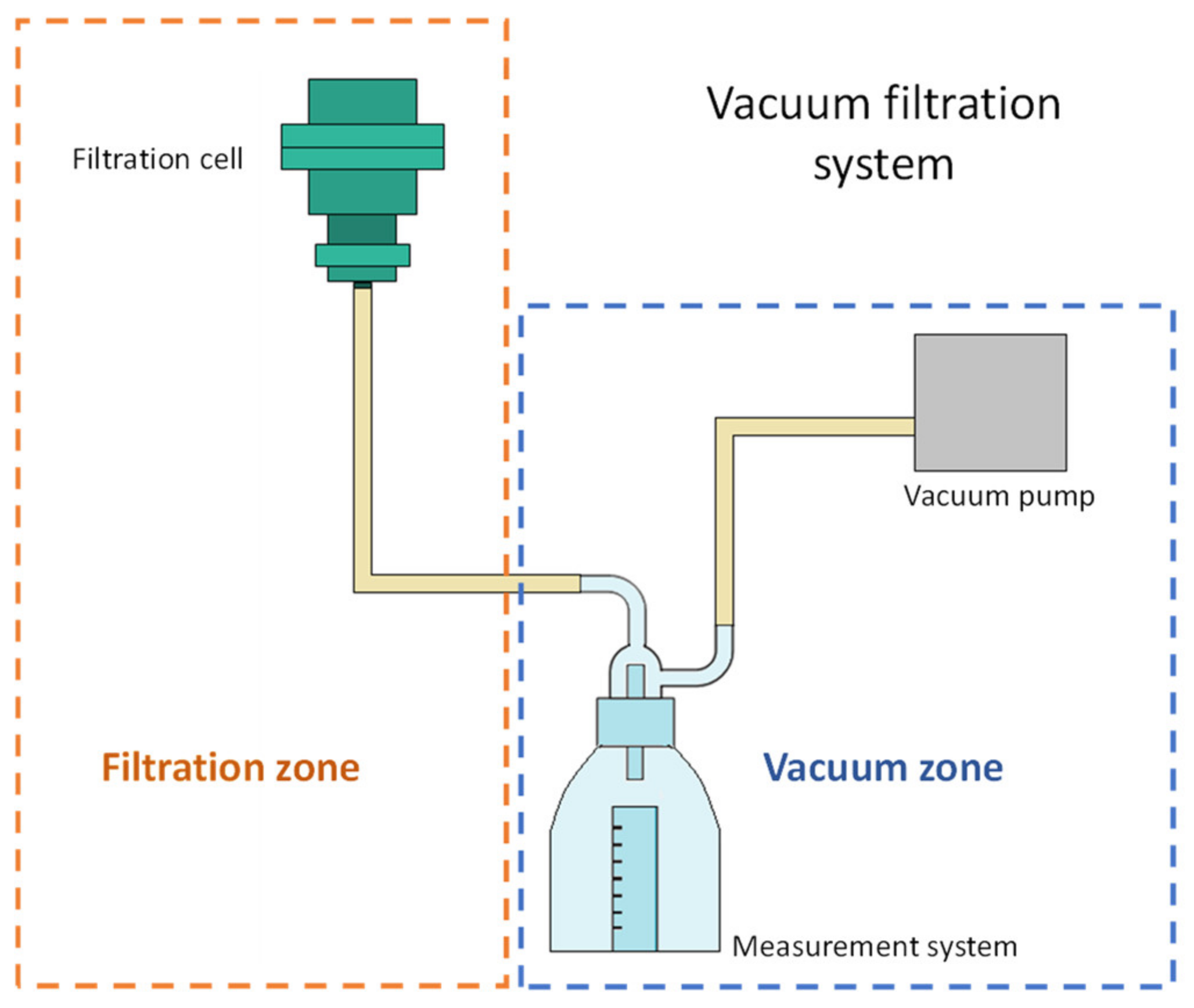

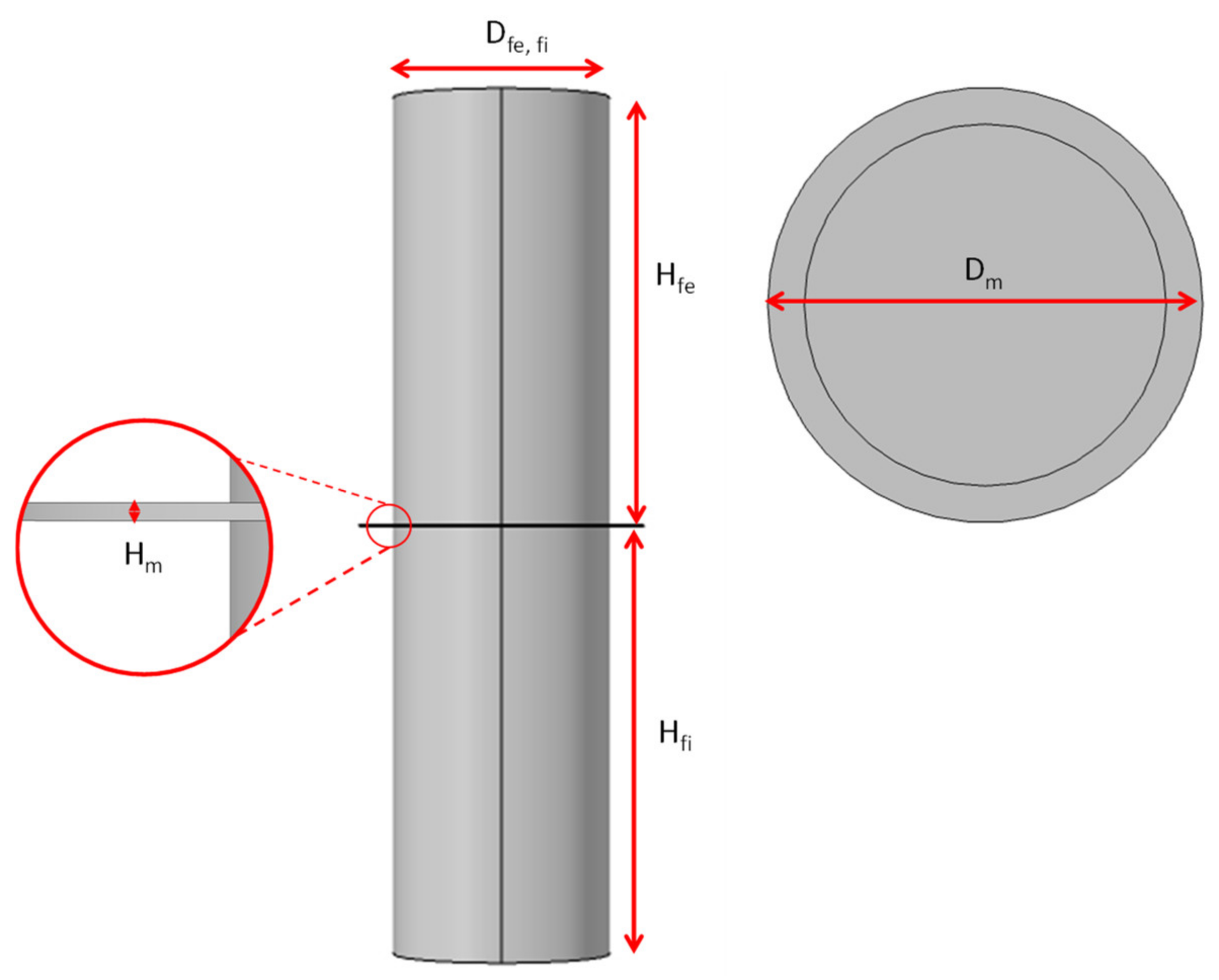
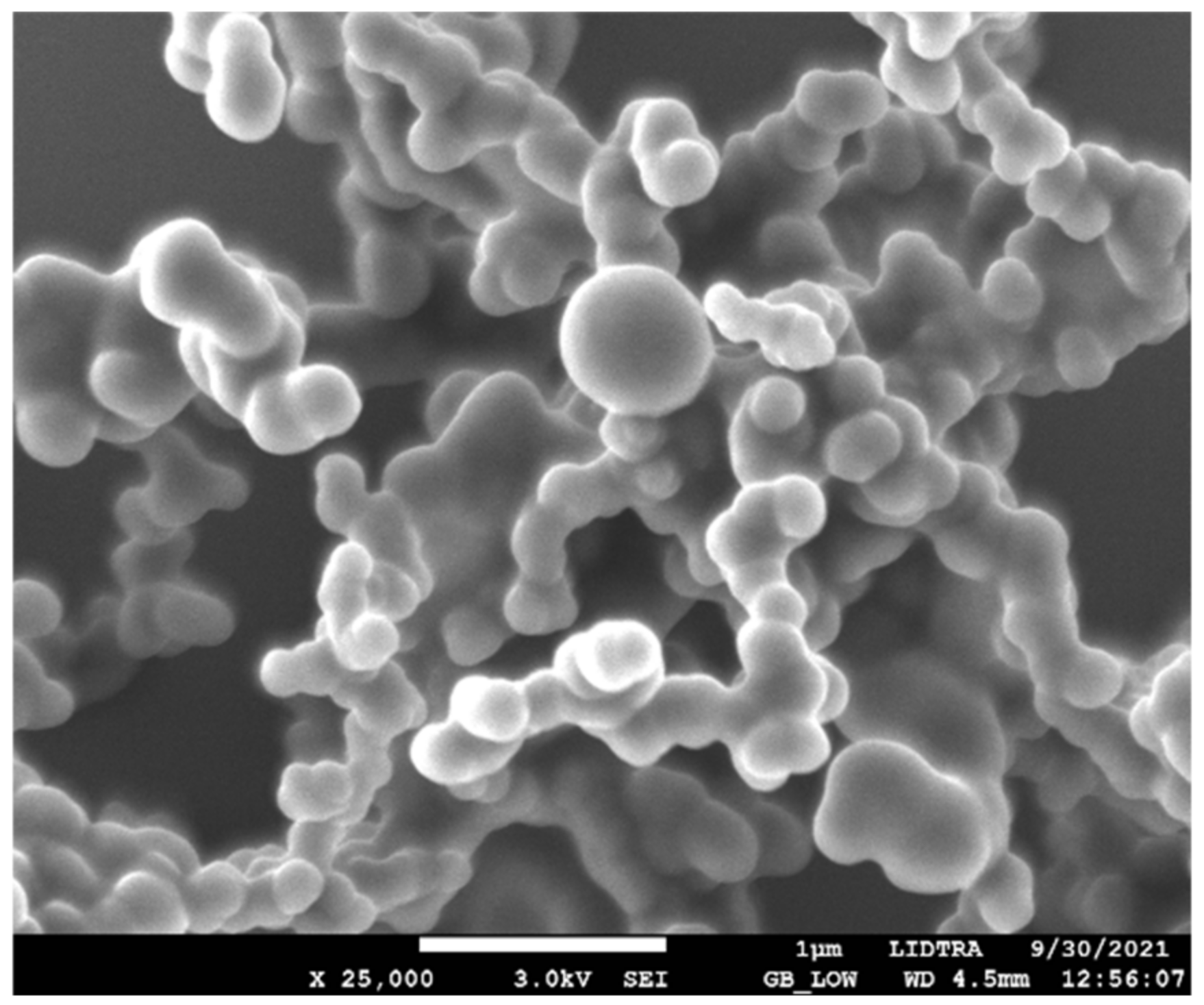
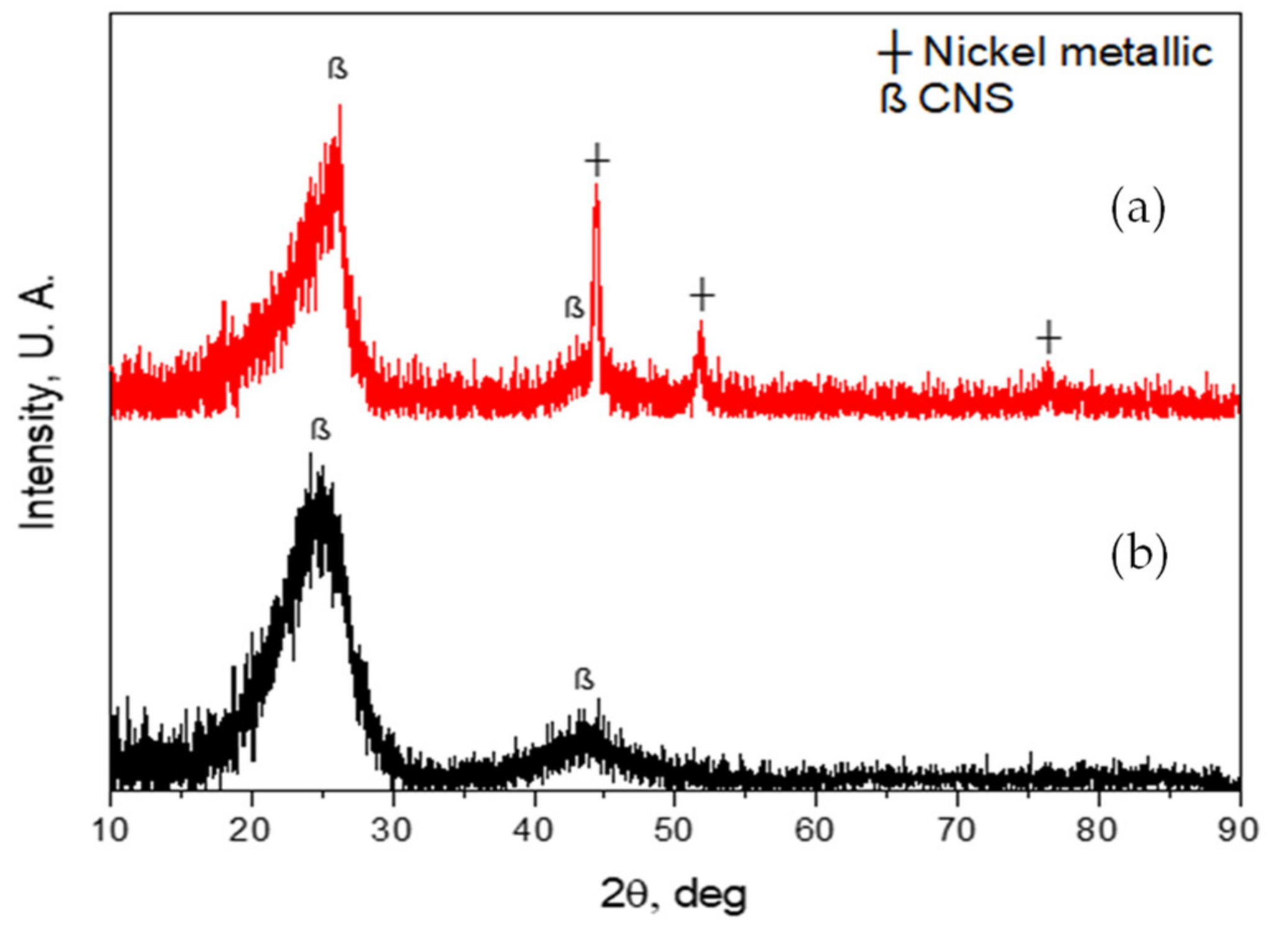


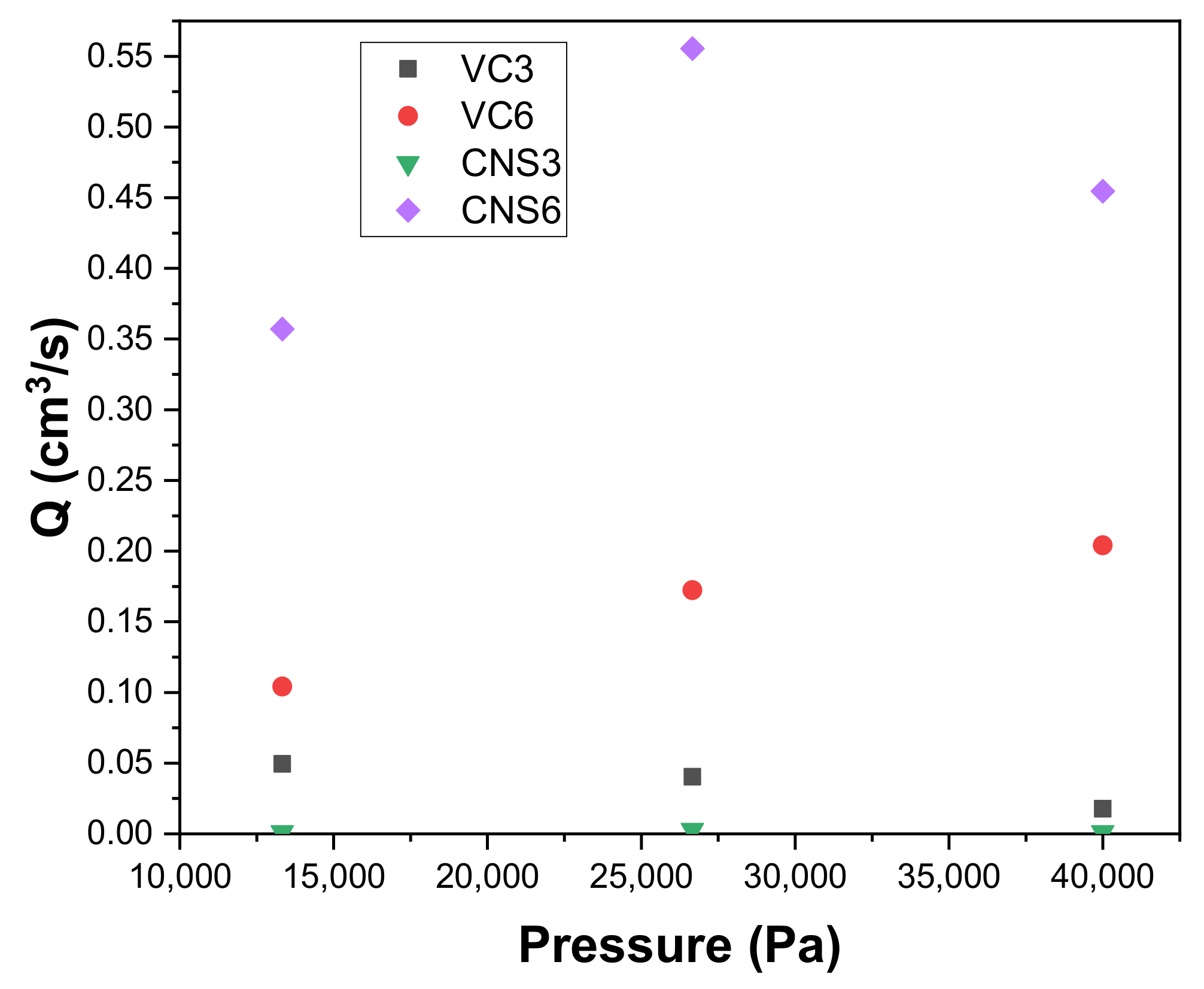
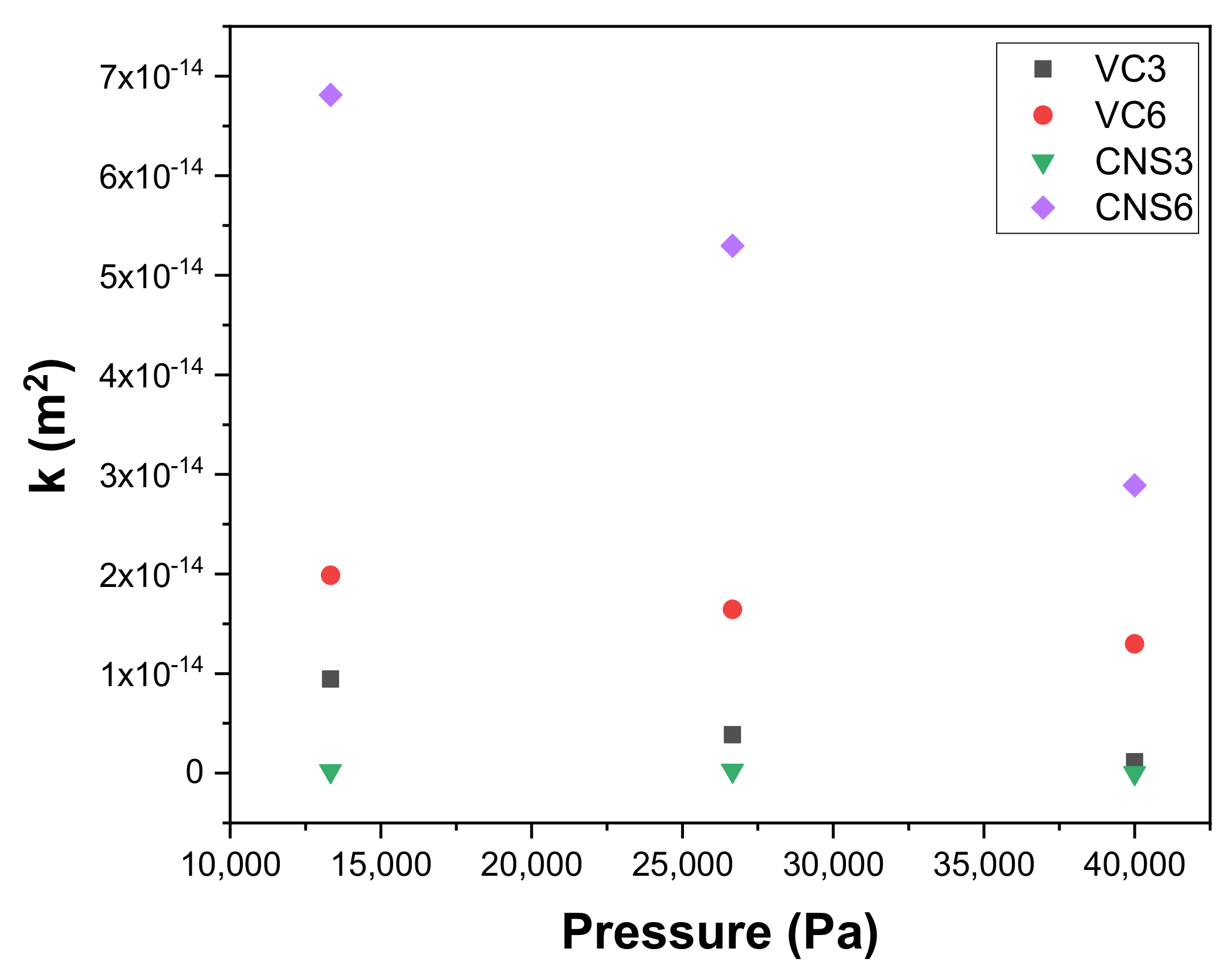
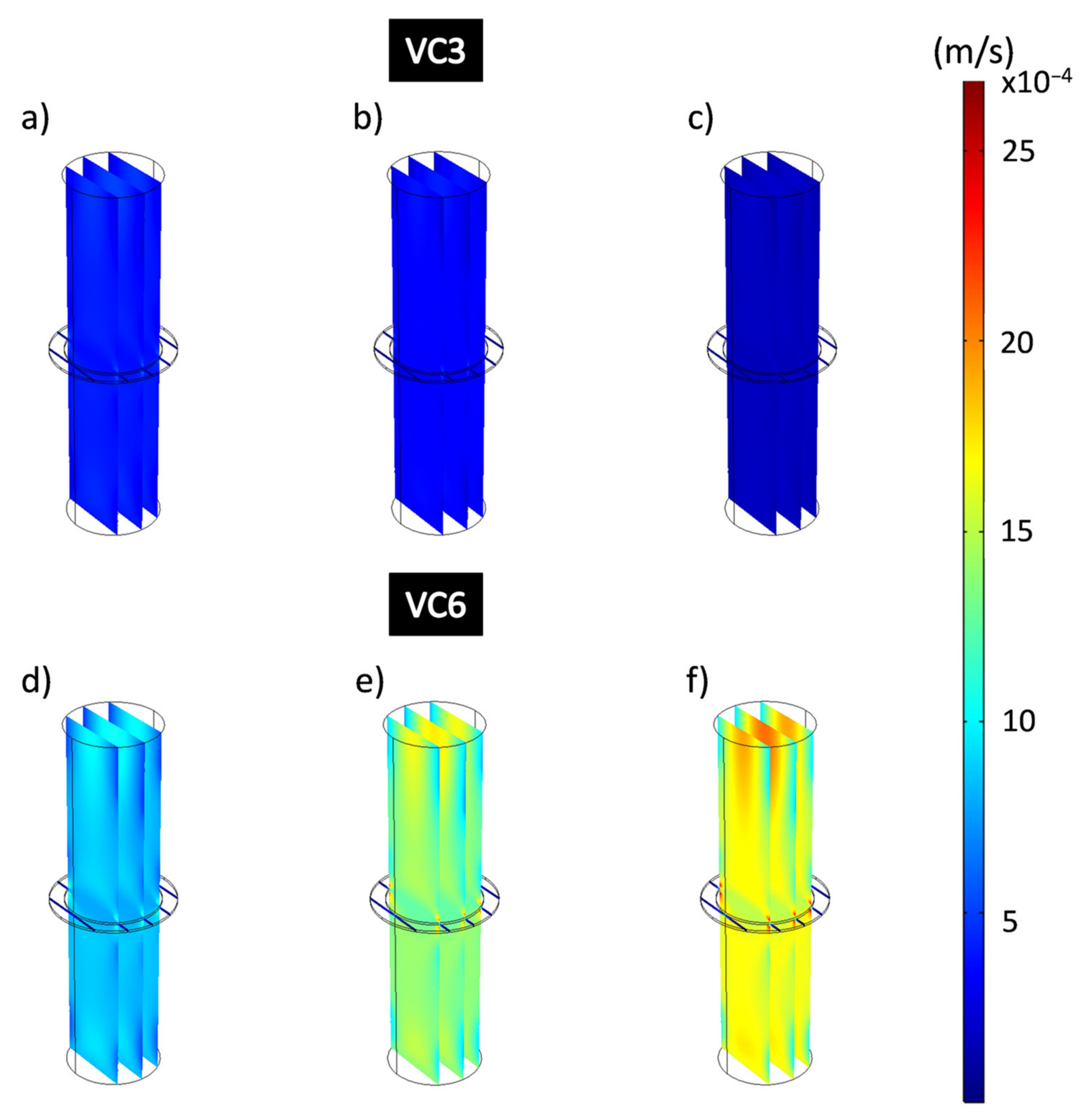
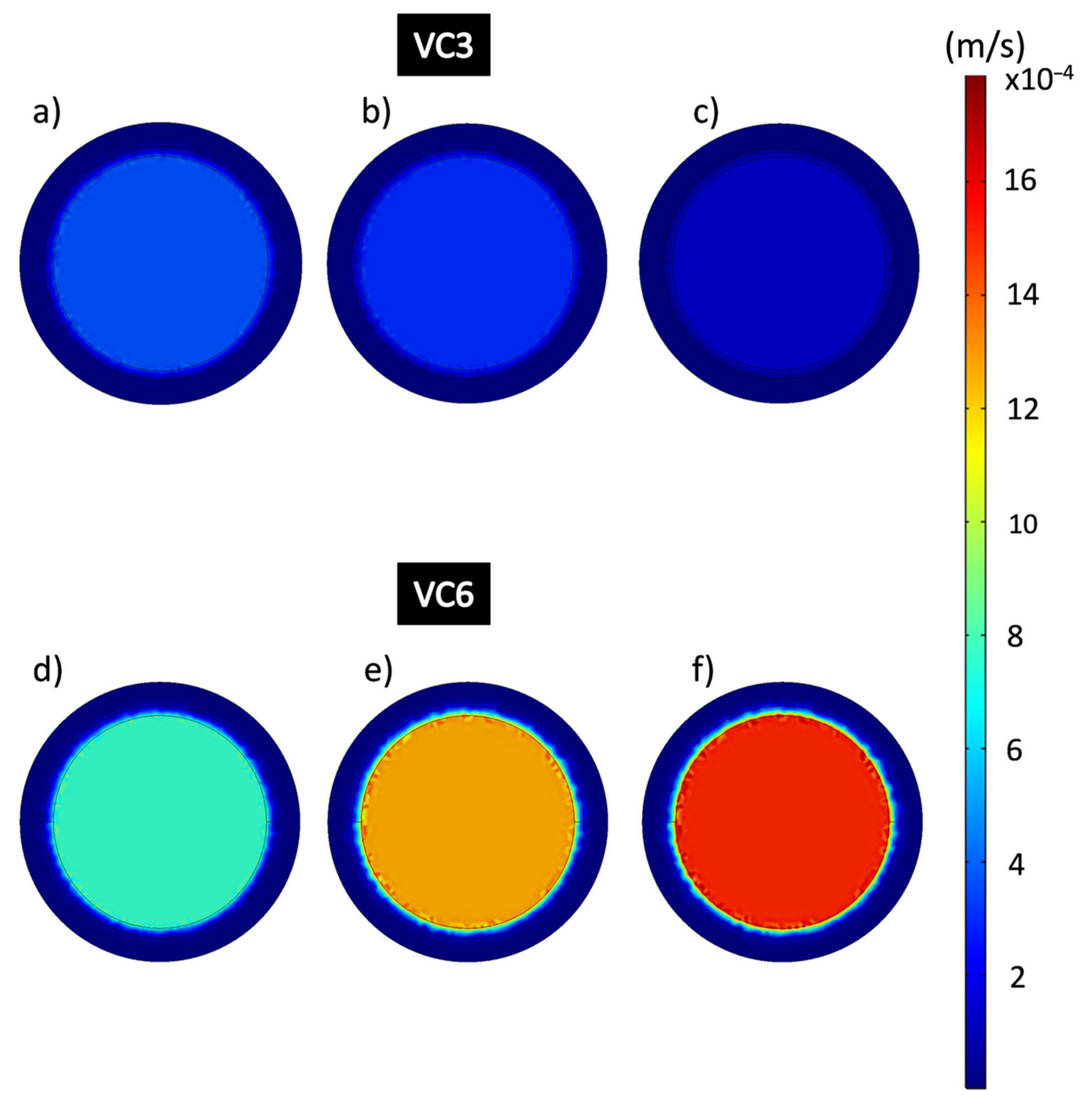
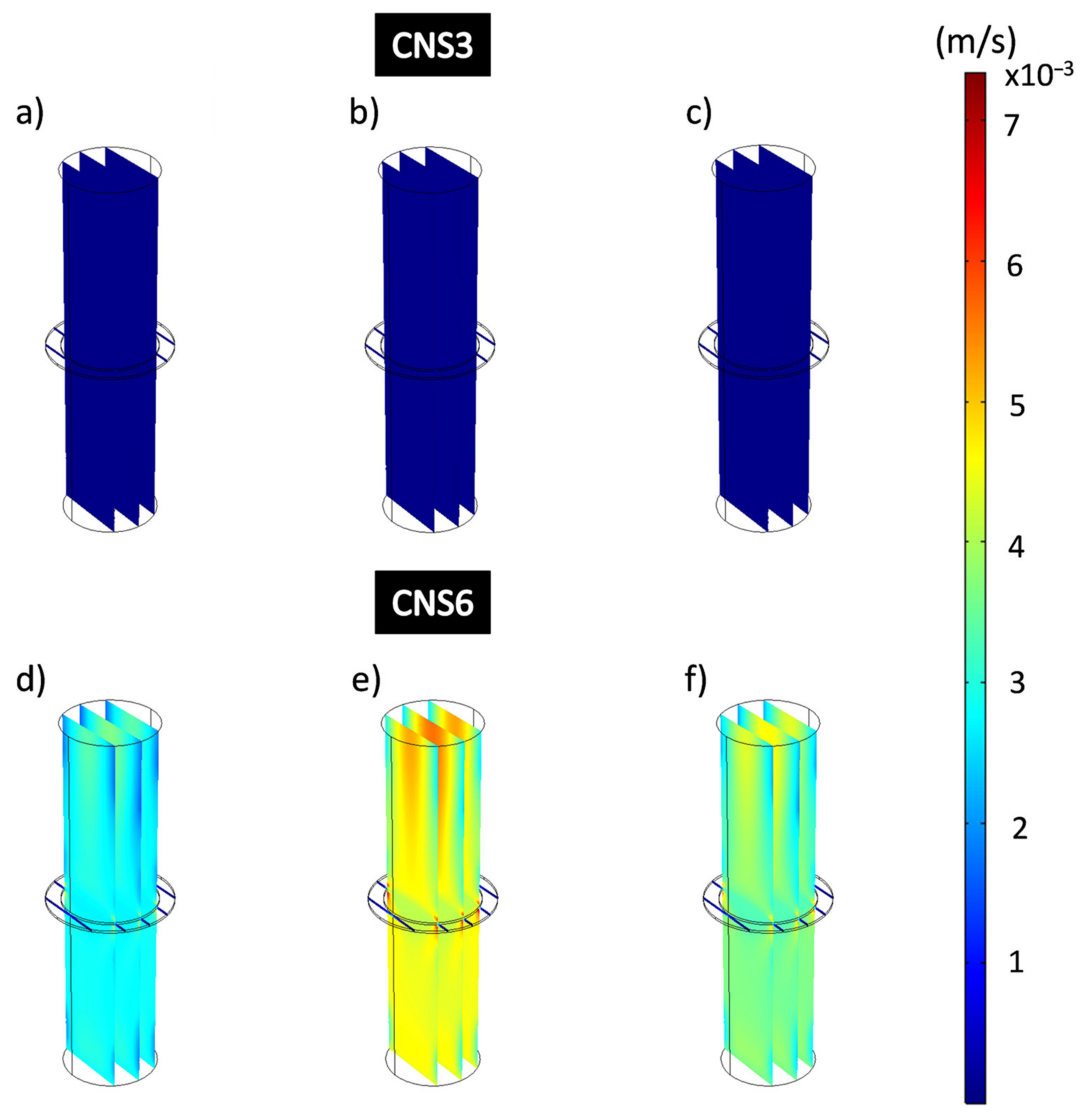
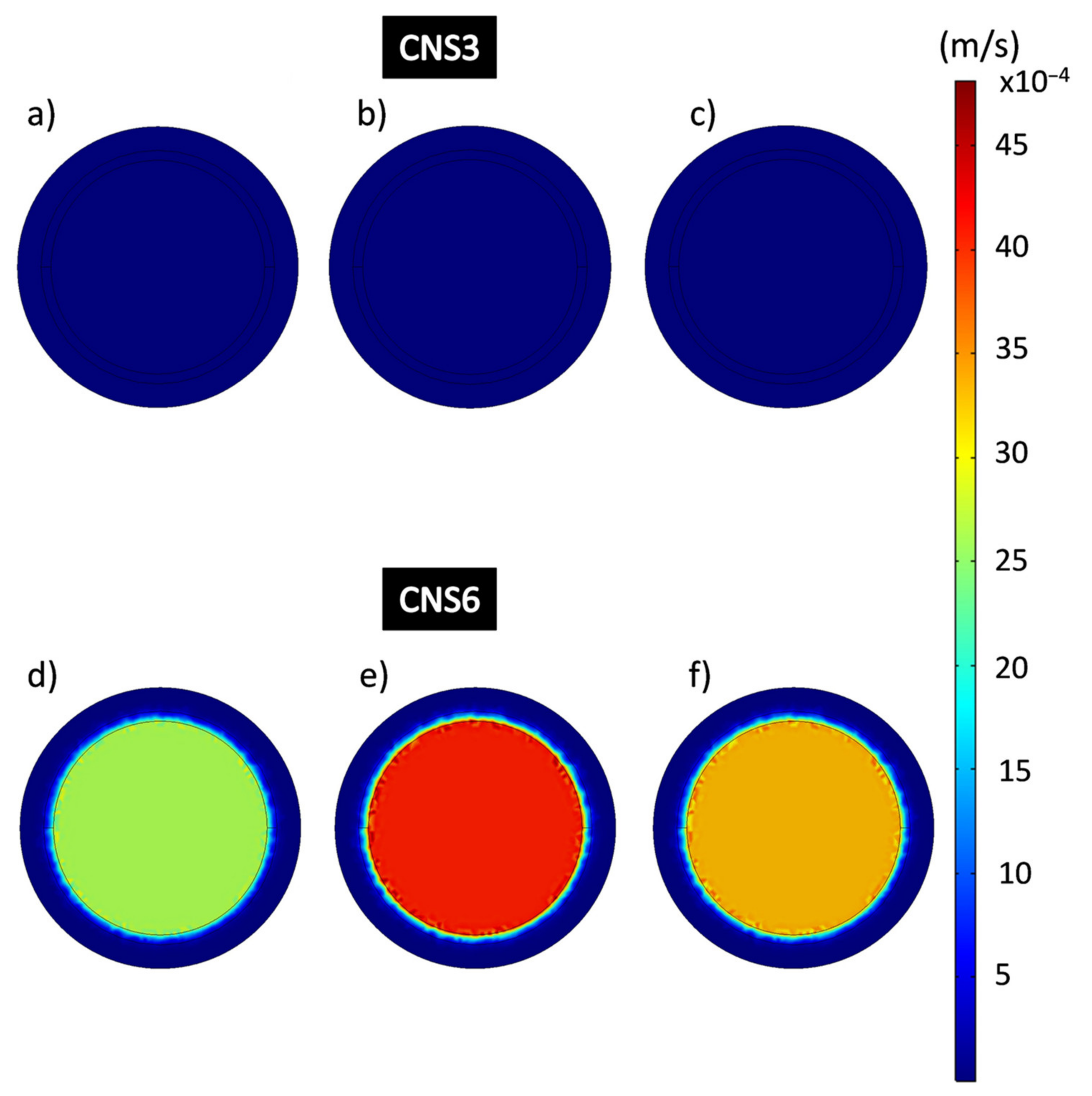
| Domain | Symbol | Description | Value |
|---|---|---|---|
| Feeding Section | Dfe | Feeding section diameter | 12.7 mm |
| Hfe | Feeding section height | 25 mm | |
| Afe | Feeding section area | 126.68 mm2 | |
| Vfe | Feeding section volume | 3167 mm3 | |
| Composite coating | |||
| Dm | Composite coating diameter | 16.7 mm | |
| Hm | Composite coating height average | 0.306 mm | |
| Filtration Section | |||
| Dfi | Filtration section diameter | 12.7 mm | |
| Hfi | Filtration section height | 25 mm | |
| Afi | Filtration section area | 126.68 mm2 | |
| Vfi | Filtration section volume | 3167 mm3 | |
| Diameter Range (µm) | Pore Count | ||||||||||||
|---|---|---|---|---|---|---|---|---|---|---|---|---|---|
| 1 | 2 | 3 | 4 | 5 | 6 | 7 | 8 | 9 | 10 | 11 | 12 | ||
| VC3 | 107 ± 0.28 | 34 ± 0.28 | 19 ± 0.34 | 12 ± 0.39 | 7 ± 0.33 | 5 ± 0.22 | 6 ± 0.11 | 6 ± 0.03 | 3 ± 0.32 | 0 | 0 | 0 | |
| Coating | VC6 | 182 ± 0.25 | 74 ± 0.34 | 0 | 1 ± 0.00 | 2 ± 0.12 | 2 ± 0.02 | 2 ± 0.30 | 3 ± 0.13 | 1 ± 0.00 | 1± 0.00 | 3 ± 0.11 | 1 ± 0.00 |
| CNS3 | 96 ± 0.34 | 33 ± 0.06 | 14 ± 0.14 | 1 ± 0.00 | 3 ± 0.29 | 4 ± 0.30 | 3 ± 0.40 | 1 ± 0.00 | 1 ± 0.00 | 1 ± 0.00 | 1 ± 0.00 | 2 ± 0.12 | |
| CNS6 | 74 ± 0.29 | 101 ± 0.27 | 37 ± 0.27 | 9 ± 0.39 | 3 ± 0.18 | 2 ± 0.18 | 0 | 0 | 2 ± 0.07 | 0 | 1 ± 0.00 | 1 ± 0.07 | |
| Coating Name | Thickness (mm) | ε (%) | Pressure Operation (Pa) | Permeated Flux (cm3/s) | Permeability (m2) |
|---|---|---|---|---|---|
| VC0 | 0.316 ± 0.003 | 1% | 13,332 | 0 | 0 |
| 26,664 | |||||
| 39,996 | |||||
| VC3 | 0.307 ± 0.002 | 35% | 13,332 | 0.0495 | 1.63 × 10−9 |
| 26,664 | 0.0403 | 6.63 × 10−10 | |||
| 39,996 | 0.0177 | 1.94 × 10−10 | |||
| VC6 | 0.305 ± 0.003 | 33% | 13,332 | 0.1042 | 3.40 × 10−9 |
| 26,664 | 0.1724 | 2.82 × 10−10 | |||
| 39,996 | 0.2041 | 2.22 × 10−9 | |||
| CNS0 | 0.312 ± 0.003 | 0.3% | 13,332 | 0 | 0 |
| 26,664 | |||||
| 39,996 | |||||
| CNS3 | 0.307 ± 0.002 | 19% | 13,332 | 0.0011 | 3.62 × 10−11 |
| 26,664 | 0.0027 | 4.44 × 10−11 | |||
| 39,996 | 0.0011 | 1.21 × 10−11 | |||
| CNS6 | 0.305 ± 0.005 | 17% | 13,332 | 0.3571 | 1.17 × 10−8 |
| 26,664 | 0.5555 | 9.08 × 10−9 | |||
| 39,996 | 0.4545 | 4.95 × 10−10 |
Publisher’s Note: MDPI stays neutral with regard to jurisdictional claims in published maps and institutional affiliations. |
© 2022 by the authors. Licensee MDPI, Basel, Switzerland. This article is an open access article distributed under the terms and conditions of the Creative Commons Attribution (CC BY) license (https://creativecommons.org/licenses/by/4.0/).
Share and Cite
Espinoza-Márquez, E.; Pineda-Delgado, J.L.; Menchaca-Rivera, J.A.; Pérez-Bueno, J.d.J.; Rodríguez-López, A.; Soto-Zarazúa, G.M.; Pérez-Robles, J.F. Synthesis and Hydrodynamic Modeling Study of Epoxy/Carbon Nanospheres (Epoxy-CNS) Composite Coatings for Water Filtration Applications. Sustainability 2022, 14, 4114. https://doi.org/10.3390/su14074114
Espinoza-Márquez E, Pineda-Delgado JL, Menchaca-Rivera JA, Pérez-Bueno JdJ, Rodríguez-López A, Soto-Zarazúa GM, Pérez-Robles JF. Synthesis and Hydrodynamic Modeling Study of Epoxy/Carbon Nanospheres (Epoxy-CNS) Composite Coatings for Water Filtration Applications. Sustainability. 2022; 14(7):4114. https://doi.org/10.3390/su14074114
Chicago/Turabian StyleEspinoza-Márquez, Estefanía, José Luis Pineda-Delgado, Juan Alejandro Menchaca-Rivera, José de Jesús Pérez-Bueno, Aaron Rodríguez-López, Genaro Martín Soto-Zarazúa, and Juan Francisco Pérez-Robles. 2022. "Synthesis and Hydrodynamic Modeling Study of Epoxy/Carbon Nanospheres (Epoxy-CNS) Composite Coatings for Water Filtration Applications" Sustainability 14, no. 7: 4114. https://doi.org/10.3390/su14074114







